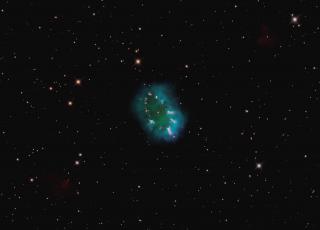Bibcode
Carpano, S.; Altieri, B.; King, A. R.; Nucita, A.; Leisy, P.
Referencia bibliográfica
Astronomy and Astrophysics, Volume 480, Issue 3, 2008, pp.807-810
Fecha de publicación:
3
2008
Revista
Número de citas
2
Número de citas referidas
2
Descripción
Aims:We report the discovery of a peculiar object observed
serendipitously with XMM-Newton. We present its timing and spectral
properties and investigate its optical counterpart. Methods: The
light curve of the X-ray source, its spectrum, and the spectrum of the
best optical counterpart are presented and analyzed. Results: The
X-ray flux decreases by a factor of 6.5 within 1 h and stays in a low
state for at least 10 h, thereby suggesting the presence of an eclipse.
The spectrum is very soft, a power law with a slope of
Γ˜2.8, and does not change significantly before and after
the flux drop. The source is spatially coincident within few arc-seconds
with a Seyfert 2 galaxy belonging to a galaxy pair. Conclusions:
Although the background AGN seems the best counterpart, neither the
temporal nor the spectral properties of the X-ray source are compatible
with it. We investigate the possibility of having a foreground low-mass
X-ray binary in quiescence, where the companion is not detected in the
optical wavelength.
Proyectos relacionados

Nebulosas Bipolares
Nuestro proyecto persigue tres objetivos principales: 1) Determinar las condiciones físico-químicas de las nebulosas planetarias con geometría bipolar y de las nebulosas alrededor de estrellas simbióticas. El fin es entender el origen de la bipolaridad y poner a prueba los modelos teóricos que intentan explicar la morfología y la cinemática nebular
Antonio
Mampaso Recio